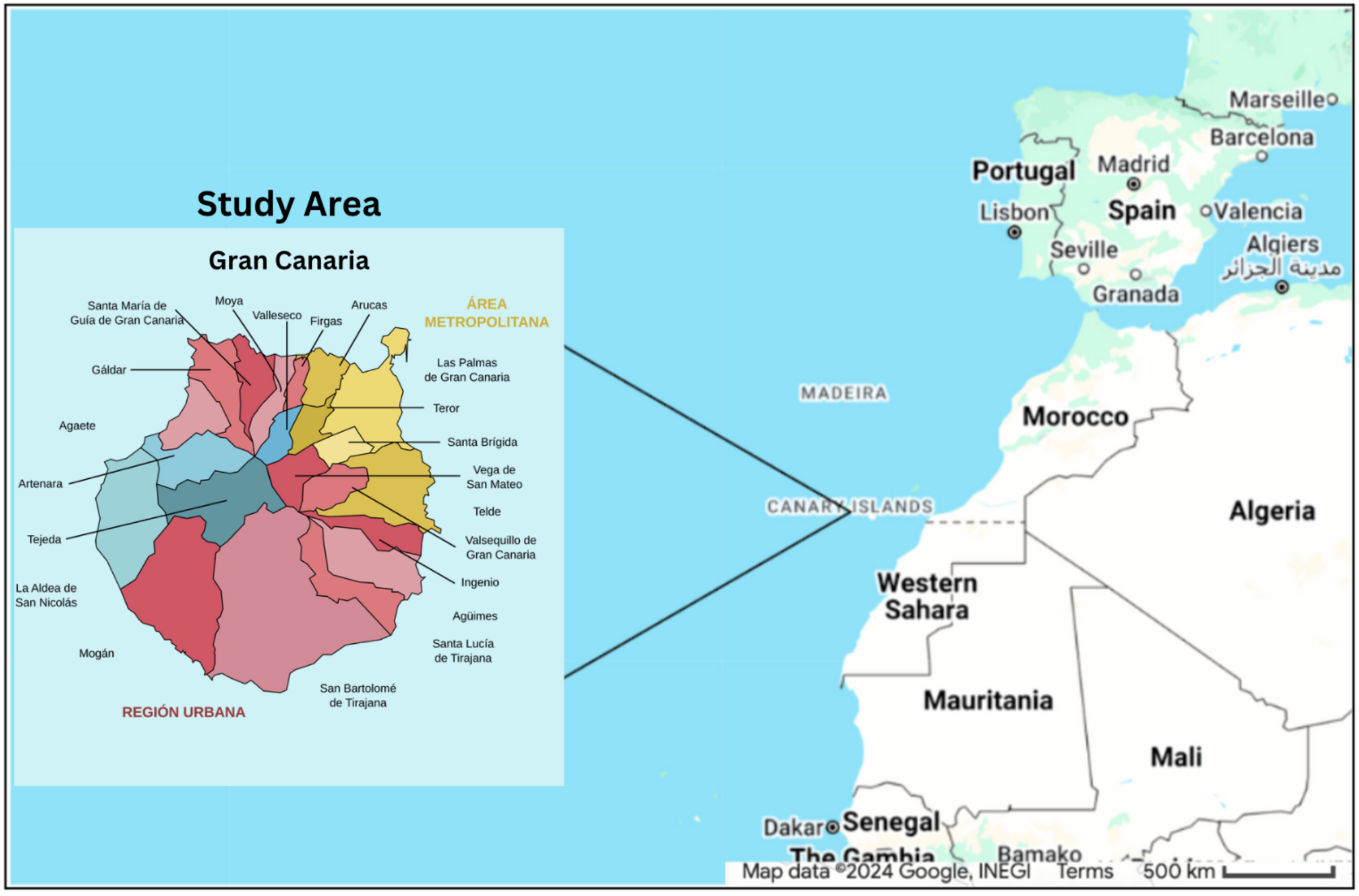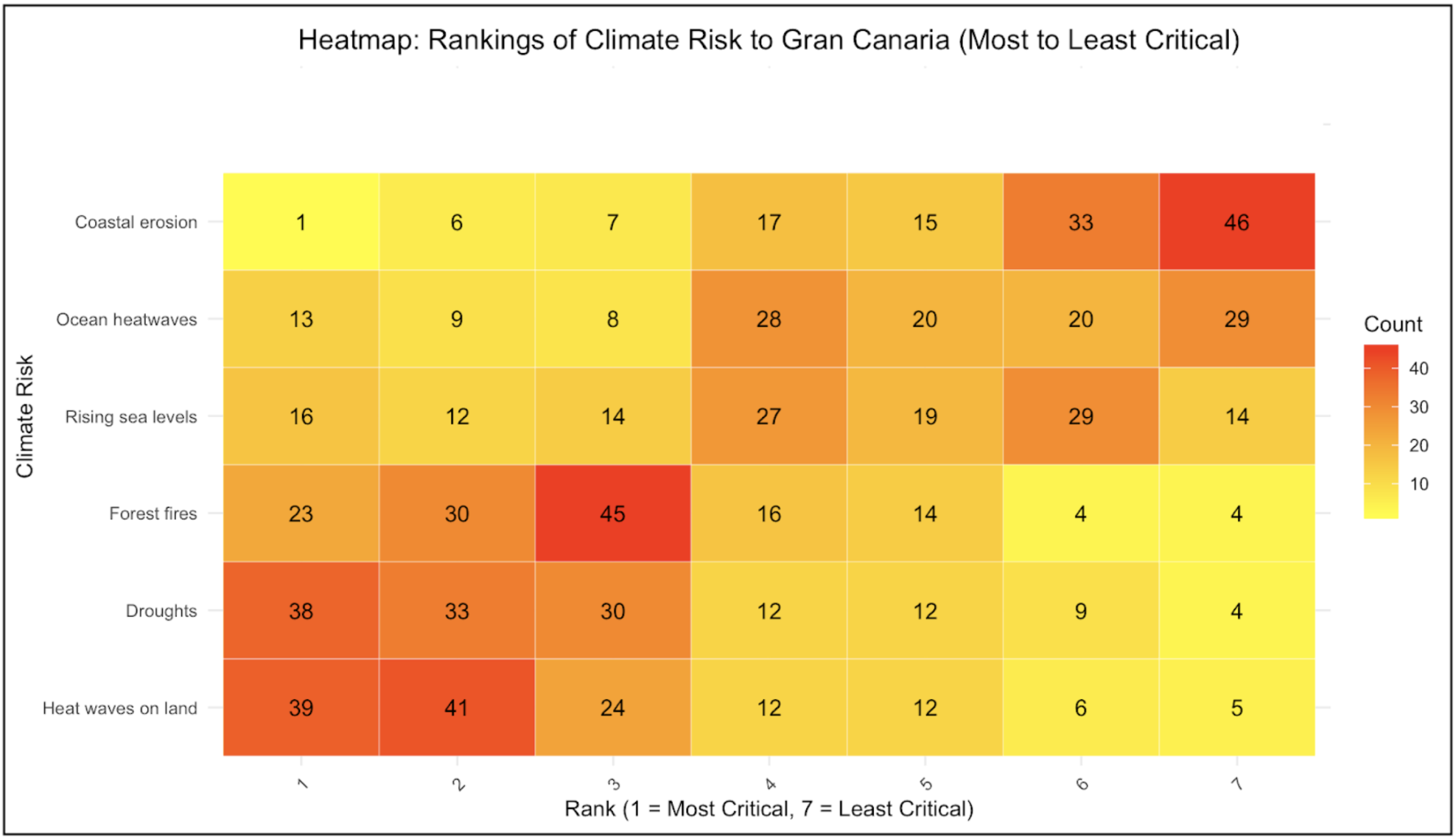Building climate resilience in Gran Canaria: insights from local communities
12 March 2025

Gran Canaria, an island located in the Spanish Canary Islands off the east coast of Africa, is facing increasing climate-related risks, with extreme heat waves and droughts identified as some of the most pressing concerns at this time. In collaboration with FutuResilience, research master’s students from the University of Groningen conducted a study to better understand the local community’s perceptions of climate-related risks, vulnerabilities, and resilience in the island.

Figure 1: Study Area: Gran Canaria. Map edited from Google Maps (2024) and Mapas de Gran Canaria (n.d.).
A key tool utilized in this research study was Maptionnaire, a digital survey platform that allows participants to manually map climate risks and where they affect their communities. A total of 146 participants completed the survey. This participatory approach provided valuable insights into how residents perceive threats and what they believe is needed to build resilience within their communities.
The use of Maptionnaire allowed participants to spatially identify climate risks, making it easier to visualize concerns and highlight areas needing attention. The results revealed significant mismatches between perceived risks and existing policies, reinforcing the need for governance structures that incorporate community knowledge into climate resilience planning.
Maptionnaire also enabled researchers to pinpoint areas where residents felt particularly vulnerable, such as coastal zones threatened by erosion, regions struggling with droughts, and urban districts suffering from extreme heat. This mapping approach demonstrated the importance of localised, data-driven decision-making in developing effective climate resilience strategies.

Figure 2: Spatial distribution of respondents’ perception of which municipalities are most affected by climate-related risks.
Key findings: community concerns and priorities
- Top climate risks: Residents ranked heat waves on land and droughts as the two most critical climate-related risks, aligning with broader scientific predictions of increasing extreme weather in the Canary Islands.
- Most vulnerable areas: San Bartolomé de Tirajana was identified as the most vulnerable municipality due to its exposure to heat waves and drought-related stressors, compounded by its high reliance on tourism, fragile ecosystems, and recurring forest fires. Historical data highlights that San Bartolomé de Tirajana has experienced significant wildfire damage, making it particularly susceptible to future climate-related risks.
- Most prepared area: Las Palmas de Gran Canaria was perceived as the most prepared municipality, likely due to existing urban infrastructure, climate adaptation strategies, and emergency response systems addressing extreme weather conditions.
- Community concerns: The greatest vulnerabilities identified were ecosystems and biodiversity, along with public health and social welfare impacts. Respondents emphasized the need for more climate-responsive policies that proactively address these issues and protect at-risk populations.
Public exclusion from decision-making: A significant finding was that most respondents felt disconnected from local climate policy decisions, highlighting a gap in participatory governance despite Spain's formal commitments to inclusive climate adaptation strategies. Many residents expressed frustration that their concerns were not being addressed in policy discussions or resilience planning efforts.

Figure 3: Heatmap showing rankings of climate-related risks to Gran Canaria from most critical (1) to least critical (7).
Community needs
Through the study, residents expressed a strong desire for policies and initiatives that prioritise:
- Urban greening initiatives – Expanding tree coverage in cities and coastal neighborhoods to mitigate heat waves, improve air quality, and provide shaded areas for residents. Participants suggested: "planting more trees in urban areas (both coastal and within neighbourhoods)" to help with cooling.
- Improved water management strategies – Addressing drought concerns by optimising water distribution, increasing rainwater harvesting, and reducing reliance on desalination, which has high energy costs and environmental impacts. One recommendation included "prioritising the development of an optimised water infrastructure, along with fair and rational distribution of available resources."
- Infrastructure improvements for extreme heat – Installing shaded areas, hydration points, and cooling stations in public spaces, particularly in vulnerable neighbourhoods with less access to natural cooling. A participant emphasized the need for "installing public fountains for hydration."
- Enhanced wildfire prevention measures – Increasing forest maintenance, controlled burns, and response resources to prevent wildfires, especially in high-risk areas prone to extreme heat and drought. Residents suggested "cleaning and removing forest waste (such as dry leaves and logging debris) on a quarterly basis to prevent the spread of fires."
- Greater public involvement in climate policy – Establishing direct channels for community participation in decision-making processes to align policies with local needs. This includes town hall meetings, digital platforms for feedback, and participatory budgeting for climate resilience projects.
- Tourism sector adaptation – Encouraging the local tourism industry to integrate climate resilience strategies, such as reducing water consumption in resorts, using renewable energy, and supporting ecosystem conservation. Participants expressed concerns about "reducing the number of golf courses and swimming pools for tourists" to ensure that local water needs are prioritised.
Moving forward: turning insights into action
The findings of this study underscore the urgent need for inclusive climate policies that integrate local knowledge, lived experiences, and community-driven solutions. As climate-related risks continue to escalate, collaborative adaptation efforts are essential in ensuring that Gran Canaria remains liveable and resilient.
Key steps forward include:
- Strengthening participatory governance – Ensuring local voices are heard in decision-making and fostering collaboration between policymakers, scientists, and community members.
- Investing in sustainable infrastructure – Developing solutions that enhance resilience to extreme heat and water scarcity while promoting long-term environmental sustainability.
- Aligning policy with lived experiences – Using the insights gathered from this study to shape policies that reflect the priorities of residents and address their most urgent climate concerns.
By incorporating community-driven solutions and prioritising resilience-building strategies, Gran Canaria can enhance its preparedness for future climate challenges and create a more sustainable future for all.
Authors: Aisling Faucon-Kamara, Lyanne Ampuero-Merino, Madi Mucha, & Steff van den Berg
Login to add a new comment